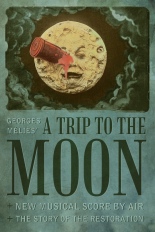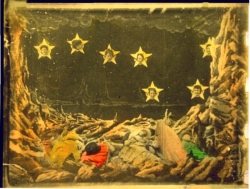
 With roughly 14 minutes, no sound and the barest of film technology, Georges Méliès sure did pack a ton of stuff into A Trip to the Moon (Le Voyage Dans La Lune if you’re French), the world’s first science-fiction film.
With roughly 14 minutes, no sound and the barest of film technology, Georges Méliès sure did pack a ton of stuff into A Trip to the Moon (Le Voyage Dans La Lune if you’re French), the world’s first science-fiction film.
After a wizard demonstrates via chalkboard the path their rocket will leave Earth and land on its near-instant journey to the lunar body, laborers build the metallic capsule. Once complete, with much pomp and circumstance, it’s loaded into a giant phallus of a cannon by chunky ladies in short pants and Buster Brown hats. With half a dozen rich, old white men as passengers, it lands with a bloody thud into the right eyesocket of that creepy, creepy moon face.
 The would-be astronauts climb out — clutching canes, but no oxygen tanks — and wave to their friends back on Earth. Then, being white-haired and all, they bunk down and sleep, wake up to a storm of stardust, and climb into the moon’s underground garden of oversized mushrooms, where hopping demons scoot their butts across a log like a dog with troubled anal glands does to your carpet. Our Earth warriors beat the crap out of them (they go up in puffs of smoke) and high-tail it home, only to land in the ocean. They get a parade in their honor, and probably got crazy laid.
The would-be astronauts climb out — clutching canes, but no oxygen tanks — and wave to their friends back on Earth. Then, being white-haired and all, they bunk down and sleep, wake up to a storm of stardust, and climb into the moon’s underground garden of oversized mushrooms, where hopping demons scoot their butts across a log like a dog with troubled anal glands does to your carpet. Our Earth warriors beat the crap out of them (they go up in puffs of smoke) and high-tail it home, only to land in the ocean. They get a parade in their honor, and probably got crazy laid.
Kidding aside, Méliès’ imagination is as off-the-charts as his ingenuity. Repopularized by Martin Scorsese’s Oscar-winning Hugo, the cinema classic is best viewed in its 2011 restored form, containing its original, hand-colored images and with missing frames mimicked. It also now boasts a score by Air that’s — dare I say it — out of this freakin’ world. This Trip truly is one. —Rod Lott
